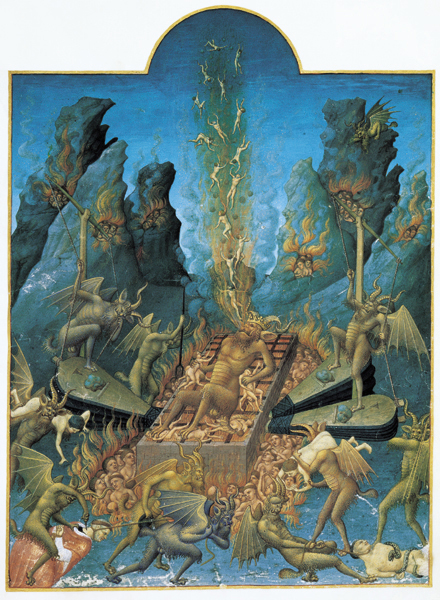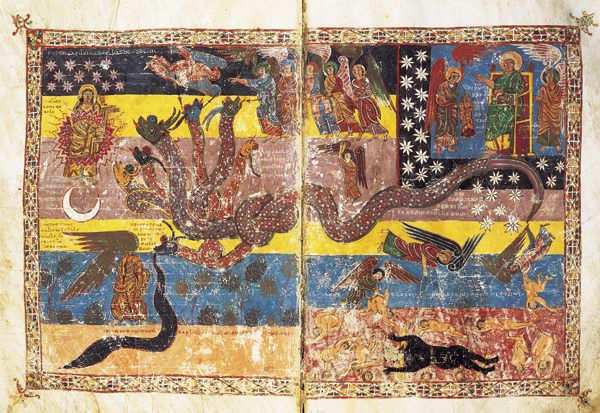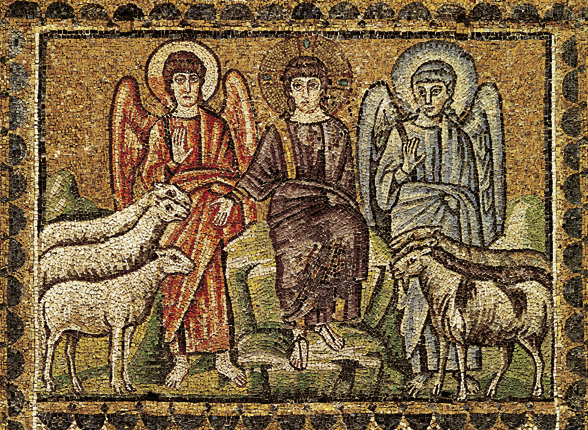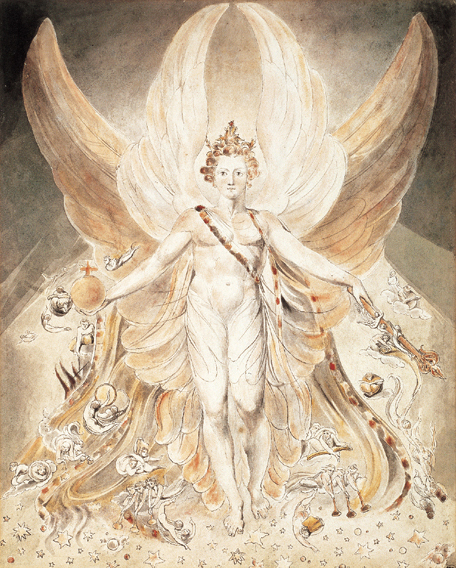
I first heard the word “lucifer” when I was a small child. My grandfather was warning me about the dangers of those long wooden matches tipped with antimony sulfide and potassium chlorate. He called them “lucifers.” Needless to say, at that time I had no idea that “lucifer” was a word of Latin derivation meaning “light-bearer.”
In my early teens, when I began reading the Bible with some degree of seriousness, I learned that “Lucifer,” capitalized this time, referred to something—or someone—far more sinister than a matchstick. I read his name in Isaiah 14:12–15:
How you have fallen from heaven,
O Lucifer, son of the dawn!You have been cast down to the earth,
you who once laid low the nations!You said in your heart,
“I will ascend to heaven;I will raise my throne above the stars of God;
I will sit enthroned on the mount of assembly,
on the utmost heights of the sacred mountain.I will ascend above the tops of the clouds;
I will make myself like the Most High.”But you are brought down to Sheol,
to the depths of the pit.1
When I asked who Lucifer was, I was told that this was one of Satan’s many names: Lucifer was none other than the Devil. Although today I know better, at the time I had no reason to doubt the equation of Lucifer with Satan—an equation that has a long history supported by the writings of the early church fathers and by countless paintings and literary accounts of the fall of Lucifer and the other rebel angels.
As a teenager, I turned to the commentary in my 1909 edition of The Scofield Reference Bible to find out more about this devious figure. The note on Isaiah 14:12 read: “Verses 12–14 evidently refer to Satan, who, as prince of this world-system…, is the real though unseen ruler of the successive world-powers, Tyre, Babylon, Medo-Persia, Greece, Rome, etc.…Lucifer, ‘day-star,’ can be none other than Satan. This tremendous passage marks the beginning of sin in the universe. When Lucifer said, ‘I will,’ sin began.”2
I tried to make sense of that paragraph in light of my admittedly rudimentary understanding of Satan. I knew that the serpent of the Garden of Eden was often equated with Satan. Indeed the serpent was even called the Devil in the New Testament Book of Revelation:
And war broke out in heaven; Michael and his angels fought against the dragon. The dragon and his angels fought back, but they were defeated, and there was no longer any place for them in heaven. The great dragon was thrown down, that ancient serpent, who is called the Devil and Satan, the deceiver of the whole world—he was thrown down to the earth, and his angels were thrown down with him.
Revelation 12:7–9
And a little further on, Revelation recounts:
Then I saw an angel coming down from heaven, holding in his hand the key to the bottomless pit and a great chain. He seized the dragon, that ancient serpent, who is the Devil and Satan, and bound him for a thousand years, and threw him into the pit and locked and sealed it over him, so that he would deceive the nations no more, until the thousand years were ended. After that he must be let out for a little while.
Revelation 20:1–3
The parallels between Isaiah 14 and these passages in Revelation were obvious to me. Although Isaiah never identifies Lucifer as Satan, it seemed clear to me that they must be the same figure. Satan-Lucifer must have rebelled against God (as in Isaiah) and been thrown out of heaven into a pit (as in Isaiah and Revelation). All of this must have transpired before the events recorded in Genesis 3, where Satan the deceiver turns up in the form of a serpent in the Garden of Eden.
Of course, I (with the assistance of C.I. Scofield) was not the first one to make this connection. The early church father Tertullian (c. 160 to 230) made the same association in his polemical treatise Against Marcion, where he describes the Devil (the name of the deceiver in Revelation) boasting that he would establish his throne in the clouds of heaven and be “like the Most High” (quoting Isaiah 14:14).3 Origen (c. 185 to 254) is even more explicit in linking Satan with Lucifer: “We are taught as follows by the prophet Isaiah…, ‘How is Lucifer, who used to arise in the morning, fallen from heaven!…’ Most evidently by these words is he shown to have fallen from heaven, who formerly was Lucifer, and who used to arise in the morning…Nay, even the Saviour Himself teaches us, saying of the devil, ‘Behold, I see Satan fallen from heaven like lightning’ [quoting Luke 10:18].”4
The formidable Augustine (354–430) soon lent his considerable intellectual weight to the discussion by commenting on Jesus’ description of the Devil in the Gospel of John: “[The Devil] was a murderer from the beginning and does not stand in the truth, because there is no truth in him” (John 8:44). Augustine interpreted this as indicating that “[the Devil] had fallen from the truth, in which, if he had abode, he would have become a partaker of it, and have remained in blessedness along with the holy angels.” Augustine then affirmed that Isaiah 14:12 refers to the Devil.5
The emerging picture of the Devil’s forced descent from heaven may be summarized as follows: In the hoary mists of eternity’s past eons, before God created the first human beings, Lucifer=Satan=the Devil was an angel of light, a respected member of the inner circle of celestial counselors. But at an undisclosed point in time, and for reasons that can no longer be discerned, he fell prey to vaunting ambition and resolved to ascend to a level above the other members of the celestial host. Indeed, he proposed to ensconce himself on a divine throne at the very top of the sacred mountain where the Lord was reputed to live. In effect, he decided that he was at least as good as, if not better than, the Most High, God himself. As a result of that supreme act of rebellion, the Lord cast him out of heaven and relegated him to the deepest part of the netherworld. And all of this is clearly documented in the soaring poetry of Isaiah 14:12–15.

It is not hard to understand why this dramatic scenario has colored our reading of Isaiah 14 since the days of the church fathers. Even Geoffrey Chaucer canonized it near the beginning of his “Monk’s Tale” (see last sidebar to this article), and John Milton refers several times to the fall of Lucifer, whom he identifies with Satan (see first sidebar to this article).
But have these theological and literary luminaries understood Isaiah correctly?
In a word, no.
There is no reason to identify the Lucifer of Isaiah with Satan. Indeed, Isaiah never mentions anyone—man or demon—named Lucifer. The proper name never appears in the original Hebrew.
So where did “Lucifer, son of the dawn”—found in early English translations such as the King James Version—come from?
The original Hebrew of Isaiah 14:12 reads
So who is this stellar “light-bearer,” this “son of the dawn”?
Just as the three most important considerations in buying real estate are location, location and location, the three most significant concerns in interpreting a biblical text are context, context and context.
Isaiah 14:12–15 is nestled among a series of oracles aimed primarily at foreign nations, including Moab, Philistia, Damascus and Egypt (Isaiah 13–23). Our poem (Isaiah 14:12–15) is part of the first oracle, which predicts the fall of Babylon (Isaiah 13–14). The second half of the prophecy (Isaiah 14:3–23) is clearly labeled a “taunt against the king of Babylon” (Isaiah 14:3–4). As we shall see, “Lucifer,” or “morning star,” as used by Isaiah, is not another name for Satan but a metaphorical reference to this Babylonian ruler.
The taunting poem heaps scorn and ridicule upon the leader. The nations he has oppressed burst forth into singing (Isaiah 14:4–7). Even nature—including cypress trees and the cedars of Lebanon—rejoices at the king’s fall (Isaiah 14:8). The spirits of deceased kings are symbolically pictured as greeting the Babylonian king when he arrives in the netherworld (Isaiah 14:9). They point out that he is just as powerless—indeed, just as dead—as they themselves are: “You too have become as weak as we! You have become like us!” (Isaiah 14:10–11).

Skipping over our poem, just a few verses later we find the dead kings pondering the Babylonian ruler’s fate: “Is this the man who made the earth tremble?” (Isaiah 14:16–17). The kings in Sheol all lie peacefully in their own tombs (Isaiah 14:18), but the Babylonian king’s corpse will be unceremoniously thrown out of his tomb and trampled underfoot (Isaiah 14:19–20). For all intents and purposes, his dynasty has come to an end: “Prepare slaughter for his sons,” Isaiah cries, “because of the guilt of their father. Let them never rise to possess the earth” (Isaiah 14:21). And all of this results from divine judgment: “I will rise up against them, says the Lord of Hosts, and will cut off from Babylon name and remnant, offspring and posterity, says the Lord. And I will make it a possession of the hedgehog and pools of water, and I will sweep it with the broom of destruction, says the Lord of Hosts” (Isaiah 14:22–23).
If this is an accurate summary of Isaiah 14:3–11 and 14:16–23, what chance is there that the verses in between, Isaiah 14:12–15, suddenly speak of Satan? Very little. In fact, verses 12–15 are totally consistent with the surrounding characterization of Babylon and its fallen ruler. Like the light of the morning star that heralds the approach of dawn but is much too faint to overwhelm it, Babylon’s powerful king—Isaiah’s metaphor tells us—fades into obscurity when compared to God Most High:
How you have fallen from heaven,
O morning star, son of the dawn!You have been cast down to the earth,
You who once laid low the nations!
When the king tries to outshine God, he can but fail. His doom is sealed.
Isaiah, the Bible tells us, prophesied “in the days of Uzziah, Jotham, Ahaz and Hezekiah, kings of Judah” (Isaiah 1:1), who ruled in the late eighth century B.C. The prophecy in Isaiah 13:1–14:27 concerns Babylonia during the days of the Assyrian Empire rather than those of the neo-Babylonian Empire, Babylon being Assyria’s most important city. Beginning in 729 B.C., the kings of Assyria assumed the title “king of Babylon” in addition to their other titles. Because of the wide range of dates that have been suggested for the authorship of the Book of Isaiah, however, various kings have been proposed as the subject of Isaiah’s oracle in Isaiah 14—Sargon II, Sennacherib, Ashur-Uballit II, Nebuchadnezzar, Nabonidus, Alexander the Great—but no consensus has been reached.6
In employing the metaphor of the “morning star, son of the dawn,” Isaiah was probably drawing on one or more ancient Near Eastern mythological sources. A close parallel, recorded on cuneiform tablets from Ugarit, appears in the humorous Canaanite myth of the minor deity ‘Athtaru, who attempted to replace Baal (also called Ba’lu) as the head of the pantheon:a
And Lady Athiratu of the Sea answered:
“Shouldn’t we make king ‘Athtaru the Rich?Let ‘Athtaru the Rich be made king!”
Then ‘Athtaru the Rich
went up into the highlands of Sapanu,
he sat down on the throne of Ba’lu the Almighty.His feet did not touch the foot-stool,
his head did not touch the top of the back.And ‘Athtaru the Rich said:
“I cannot be king in the highlands of Sapanu!”
‘Athtaru the Rich descended, he descended from the throne of Ba’lu the
Almighty and became king on all the divine earth.7
Like Isaiah’s morning star, ‘Athtaru attempts to outshine the supreme deity, only to fall from heaven to earth.
Other Canaanite tablets refer to hll, the god of the crescent moon, whom some scholars equate with Isaiah’s helel.8
Isaiah may also have drawn on the Babylonian epic of Gilgamesh. Near the end of the poem, the hero Gilgamesh finally meets Utnapishtim, a man who survived the Great Flood and was made immortal. Isaiah’s very words recall those of Gilgamesh as he asks Utnapishtim how he ascended to the level of divinity:
|
Gilgamesh said to him, “As I look upon thee,
Utnapishtim, Thy features are not strange; even as I art thou. Thou art not strange at all; even as I art thou. My heart had regarded thee as resolved to do battle,
[Yet] thou liest indolent upon thy back! [Tell me,] how joindest thou the Assembly of the gods, In thy quest of life?9 |
“Those who see you stare at you” (Isaiah 14:16)
“You have become like us” (Isaiah 14:10) “I will sit enthroned on the mount of assembly” (Isaiah 14:13) |
Ironically, if Isaiah was alluding to Gilgamesh, he was making use of a Babylonian epic to ridicule a Babylonian king.
It is perhaps best, however, to conclude that no single myth explains all of the allusions in Isaiah’s taunting song.10 As Robert O’Connell writes: “Even without a precise identification of the culture of origin for the mythic language in [Isaiah 14:12–14, ] it is clear that its function is to portray the Mesopotamian tyrant as a mythic usurper who arrogantly attempts to exceed his proper status and to take the place of the most high god.”11
So the morning star, son of the dawn, is a vivid metaphor symbolizing a Babylonian king who, like Venus, was outshone by a still brighter star. “The mythical mind saw a cosmic battle…in the brilliant rise of the morning star in the heavens with its sudden dimming before the increasing rays of the sun,” notes Brevard S. Childs. “The prophetic writer…compares the mighty king of Babylon to the upstart, Helal. He also had a brilliant start, but then Yahweh hurled him down to become the laughing stock of the nations.”12 As Isaiah himself would later say, “Babylon has fallen, has fallen!” (Isaiah 21:9; cf. Revelation 18:2).
We can no longer insist that “lucifer” is a proper noun referring primarily to Satan. As Robert Alden writes: “The king of Babylon is gone and heard from no more. Not so Satan. His ‘fall’ marked the beginning of his wicked reign. The king of Babylon’s fall marked the end of his wicked reign. Lucifer cannot be Satan.”13
But it is also true that since the days of the tower of Babel (Genesis 11:1–9), the name of Babylon has been applied to political and religious stood as the embodiment of worldly corruption and evil. In New Testament times, for example, Babylon came to be identified with Rome and its hostility toward early Christians.
Babylon’s king in Isaiah 14 embodied satanic power, and he may well be understood as prefiguring the “beast” (Revelation 13:1–3) and the Babylon of the last days—the harlot who rides the beast, corrupts kings, and drinks the blood of saints and martyrs (Revelation 17:3–8). It is striking indeed that the ruins of the latter-day “Babylon” are pictured as a “home for demons and a haunt for every unclean spirit” (Revelation 18:2). The Devil fell, falls and will fall again. God Most High can always be counted on to overwhelm the demonic powers of every Babylon, whether earthly or heavenly.14
“Lucifer” is fallen, in more ways than one.
MLA Citation
Footnotes
In 1928 a Syrian farmer accidentally struck a tomb with his plow at Ras Shamra, on the northern coast of Syria. Subsequent excavations revealed the remains of the 14th-century B.C. city of Ugarit. Archaeologists discovered thousands of cuneiform tablets here. Several found in the library of the chief priest of the temple of Baal record the major Canaanite myths.
Endnotes
The translation is that of the New International Version (except that “Lucifer” has been substituted for “morning star” and “Sheol” for “the grave”).
Augustine, City of God 11.13–15; cf. Augustine, The City of God, trans. Marcus Dods (New York: Modern Library, 1950), pp. 358–359.
See Hans Wildberger, Isaiah 13–27 (Minneapolis: Fortress, 1997), pp. 54–55. It is perhaps best to agree with the words of Robert H. O’Connell: “A precise identification of a particular historical figure seems unlikely” (“Isaiah xiv 4b–23: Ironic Reversal Through Concentric Structure and Mythic Allusion,” Vetus Testamentum 38:4 [1988], p. 417).
The translation is that of Johannes C. de Moor, An Anthology of Religious Texts from Ugarit (Leiden: Brill, 1987), pp. 85–86.
For opposing opinions on this matter, cf., e.g., de Moor, An Anthology of Religious Texts, p. 145 n. 33, which identifies the two, and J.C.L. Gibson, Canaanite Myths and Legends, 2nd ed. (Edinburgh: T. & T. Clark, 1978), p. 29 n. 1, which denies the equation.
This stanza is found in tablet 11, lines 1–7. The translation is that of E.A. Speiser (The Ancient Near East: An Anthology of Texts and Pictures ed. James B. Pritchard [Princeton, NJ: Princeton Univ. Press, 1958], pp. 65–66).
Many scholars readily admit this. See, for example, John N. Oswalt, The Book of Isaiah: Chapters 1–39 (Grand Rapids: Eerdmans, 1986), p. 322; Wildberger, Isaiah 13–27, pp. 63, 65; W.S. Prinsloo, “Isaiah 14:12–15—Humiliation, Hubris, Humiliation,” Zeitschrift für die alttestamentliche Wissenschaft 93 (1981), p. 438 n. 35.
Brevard S. Childs, Myth and Reality in the Old Testament, Studies in Biblical Theology 27 (London: SCM, 1960), p. 69.
Robert L. Alden, “Lucifer, Who or What?” Bulletin of the Evangelical Theological Society 11 (1968), p. 38.




